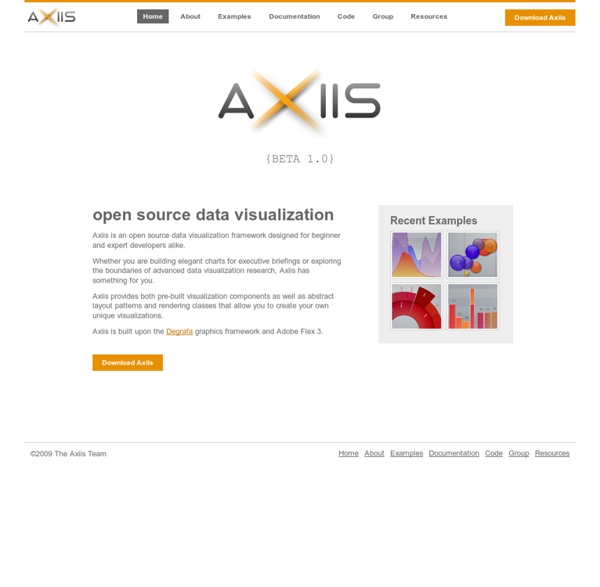Axiis : Data Visualization Framework
Axiis: Data Visualization Framework! open source data visualization Axiis is an open source data visualization framework designed for beginner and expert developers alike. Whether you are building elegant charts for executive briefings or exploring the boundaries of advanced data visualization research, Axiis has something for you. Axiis provides both pre-built visualization components as well as abstract layout patterns and rendering classes that allow you to create your own unique visualizations. Axiis is built upon the Degrafa graphics framework and Adobe Flex 3.
http://www.axiis.org/
Related: HighTech
5 of the Best Free and Open Source Data Mining Software
The process of extracting patterns from data is called data mining. It is recognized as an essential tool by modern business since it is able to convert data into business intelligence thus giving an informational edge. At present, it is widely used in profiling practices, like surveillance, marketing, scientific discovery, and fraud detection. There are four kinds of tasks that are normally involve in Data mining:
Protovis
Protovis composes custom views of data with simple marks such as bars and dots. Unlike low-level graphics libraries that quickly become tedious for visualization, Protovis defines marks through dynamic properties that encode data, allowing inheritance, scales and layouts to simplify construction. Protovis is free and open-source, provided under the BSD License.
Anzo views
Web Dashboards That Do Much More Looking to do some serious analysis of data scattered across Excel spreadsheets? Anzo web dashboards give you everything you'd expect from a state-of-the-art business reporting tool, and much more. Like most reporting tools, Anzo lets non-technical users create new tables, charts, and drill-downs in minutes. You can also choose from eight different types of filters to quickly narrow down your data to what's most relevant to you.
Declarative Graphics Framework
Degrafa: Declarative Graphics Framework Samples Code
Data Mining
Image: Detail of sliced visualization of thirty video samples of Downfall remixes. See actual visualization below. As part of my post doctoral research for The Department of Information Science and Media Studies at the University of Bergen, Norway, I am using cultural analytics techniques to analyze YouTube video remixes. My research is done in collaboration with the Software Studies Lab at the University of California, San Diego. A big thank you to CRCA at Calit2 for providing a space for daily work during my stays in San Diego. The following is an excerpt from an upcoming paper titled, “Modular Complexity and Remix: The Collapse of Time and Space into Search,” to be published in the peer review journal AnthroVision, Vol 1.1.
blog » Hexbins!
Binning is a general term for grouping a dataset of N values into less than N discrete groups. These groups/bins may be spatial, temporal, or otherwise attribute-based. In this post I’m only talking about spatial (long-lat) and 2-dimensional attribute-based (scatterplot) bins.
Eureqa
Eureqa is a breakthrough technology that uncovers the intrinsic relationships hidden within complex data. Traditional machine learning techniques like neural networks and regression trees are capable tools for prediction, but become impractical when "solving the problem" involves understanding how you arrive at the answer. Eureqa uses a breakthrough machine learning technique called Symbolic Regression to unravel the intrinsic relationships in data and explain them as simple math.
About Google+ Ripples - Google+ Help
Google+ Ripples creates an interactive graphic of the public shares of any public post or URL on Google+ to show you how it has rippled through the network and help you discover new and interesting people to follow. Ripples shows you: People who have reshared the link will be displayed with their own circle. Inside the circle will be people who have reshared the link from that person (and so on). Circles are roughly sized based on the relative influence of that person.
Related:


